Experimental Study on Purification Effect of Biochemical Pool Model for Treatment of Pavement Runoff by Aquatic Plants
Abstract
:1. Introduction
2. Study Plan
2.1. Selection of Test Elements
2.1.1. Aquatic Plant Selection
2.1.2. Preparation of Experimental Runoff Water
2.1.3. Biochemical Model Pond Test Chamber
2.2. Research Design and Method
2.2.1. Cultivation of Aquatic Plants in Biochemical Model Pond
2.2.2. Test of Runoff Pollution Adsorption and Diffusion Purification Effects During Rainfall
2.2.3. Experiment on Purification Effect of Remaining Runoff Polluted Water Degradation
2.3. Evaluation Criteria
3. Results and Discussions
3.1. Effects of Planting Patterns of Aquatic Plants on Runoff Water Quality Purification
3.2. Dynamic Influence on Runoff Pollution Degradation and Purification Process
4. Conclusions
Author Contributions
Funding
Conflicts of Interest
References
- Qian, G.; Yu, H.; Gong, X.; Zhao, L. Impact of Nano-TiO2 on the NO2 degradation and rheological performance of asphalt pavement. Constr. Build. Mater. 2019, 218, 53–63. [Google Scholar] [CrossRef]
- Yu, H.; Bai, X.; Qian, G.; Wei, H.; Gong, X.; Jin, J.; Li, Z. Impact of ultraviolet radiation on the aging properties of SBS-modified asphalt binders. Polymers 2019, 11, 1111. [Google Scholar] [CrossRef] [PubMed] [Green Version]
- Wong, T.H.F.; Somes, N.L.G. A stochastic approach to designing wetlands for stormwater pollution control. Water Sci. Technol. 1995, 32, 145–153. [Google Scholar] [CrossRef]
- Stotz, G. Investigations of the properties of the surface water runoff from federal highways in the FRG. Sci. Total Environ. 1987, 59, 329–337. [Google Scholar] [CrossRef]
- Drapper, D.; Tomlinson, R.; Williams, P. Pollutant Concentrations in Road Runoff: Southeast Queensland Case Study. J. Environ. Eng. 2000, 126, 313–320. [Google Scholar] [CrossRef]
- Holffman, E.J. Urban runoff inputs to Narragansett Bay; Comparison to point sources. In Perspectives on Non-Point Source Pollution Proceedings, National Conference; USEPA: Washington, DC, USA, 1985; pp. 159–164. [Google Scholar]
- Gan, H.Y.; Zhuo, M.N.; Li, D.Q.; Zhou, Y.Z. Characteristics of heavy metal pollution in highway pavement runoff. Urban Environ. Urban Ecol. 2007, 20, 34–37. [Google Scholar]
- Zhao, J.Q. Study on Road Pavement Runoff Pollution Characteristics and Drainage Rules. Ph.D. Thesis, Xi’an University of Architecture and Technology, Xi’an, China, 2000. [Google Scholar]
- Byeon, S.J.; Koo, B.J.; Jang, D.W.; Baeck, S.H. Characteristics of Rainfall Runoff Pollutant and Initial Treatment. Sustainability 2016, 8, 450. [Google Scholar] [CrossRef] [Green Version]
- Abrahams, J.C.; Coupe, S.J.; Sañudo-Fontaneda, L.A.; Schmutz, U. The Brookside Farm Wetland Ecosystem Treatment (WET) System: A Low-Energy Methodology for Sewage Purification, Biomass Production (Yield), Flood Resilience and Biodiversity Enhancement. Sustainability 2017, 9, 147. [Google Scholar] [CrossRef] [Green Version]
- Gong, Y.W.; Hao, Y.; Li, J.Q.; Li, H.Y.; Shen, Z.Y.; Wang, W.H.; Wang, S. The Effects of Rainfall Runoff Pollutants on Plant Physiology in a Bioretention System Based on Pilot Experiments. Sustainability 2019, 11, 6402. [Google Scholar] [CrossRef] [Green Version]
- Muerdter, C.P.; Wong, C.K.; Lefevre, G.H. Emerging investigator series: The role of vegetation in bioretention for stormwater treatment in the built environment: Pollutant removal, hydrologic function, and ancillary benefits. Environ. Sci. Water Res. Technol. 2018, 4, 592–612. [Google Scholar] [CrossRef]
- Blanco, J.A. Suitability of Totora (Schoenoplectus californicus (C.A. Mey) Soják) for Its Use in Constructed Wetlands in Areas Polluted with Heavy Metals. Sustainability 2018, 11, 19. [Google Scholar] [CrossRef] [Green Version]
- Pozdniakova, T.A.; Mazur, L.P.; Boaventura, R.A.R.; Vilar, V.J. Brown macro-algae as natural cation exchangers for the treatment of zinc containing wastewaters generated in the galvanizing process. J. Clean. Prod. 2016, 119, 38–49. [Google Scholar] [CrossRef]
- Abraham, J.; Lin, Y.X.; Roychowdhury, A.; Christodoulatos, C.; Conway, M.; Smolinski, B.; Braida, W. Algae toxicological assessment and valorization of energetic-laden wastewater streams using Scenedesmus obliquus. J. Clean. Prod. 2018, 202, 838–845. [Google Scholar] [CrossRef]
- Law, E.P.; Diemont, S.A.W.; Toland, T.R. A sustainability comparison of green infrastructure interventions using emergy evaluation. J. Clean. Prod. 2017, 145, 374–385. [Google Scholar] [CrossRef]
- Nayak, M.; Dhanarajan, G.; Dineshkumar, R.; Sen, R. Artificial intelligence driven process optimization for cleaner production of biomass with co-valorization of wastewater and flue gas in an algal biorefinery. J. Clean. Prod. 2018, 201, 1092–1100. [Google Scholar] [CrossRef]
- Wu, S.Q.; Gao, L.; Gu, J.Y.; Zhou, W.L.; Fan, C.Z.; He, S.B.; Huang, J.C.; Zhang, X.; Cheng, Y.F.; Wu, Z.W.; et al. Enhancement of nitrogen removal via addition of cattail litter in surface flow constructed wetland. J. Clean. Prod. 2018, 204, 205–211. [Google Scholar] [CrossRef]
- Yu, H.; He, Z.; Qian, G.; Gong, X.; Qu, X. Research on the anti-icing properties of silicone modified polyurea coatings (SMPC) for asphalt pavement. Constr. Build. Mater. 2020, 242, 117793. [Google Scholar] [CrossRef]
- Yu, H.; Shi, C.; Qian, G.; Gong, X. Experimental study on thermophysical properties of HMA during compaction. Int. J. Pavement Eng. 2019, 1–12. [Google Scholar] [CrossRef]
- Song, Z.Z.; Zhong, X.X. Effects of potassium supply level on the ability of three heavy metals enrichment in rhizopus chinensis. Guangxi Sci. 2013, 20, 66–70. [Google Scholar]
- Zhu, Y.L.; Zayed, A.M.; Qian, J.H.; de Souza, M.; Terry, N. Phtoaccumulation of trace elements by wetland plants II. Water hyacinth. J. Environ. Qual. 1999, 28, 339–344. [Google Scholar] [CrossRef]
- Klumpp, A.; Bauer, K.; Franz-Gerstein, C.; Menezes, M. Variation of nutrient and metal concentrations in aquatic macrophytes along the Rio Cachoeira in Bahia (Brazil). Environ. Int. 2002, 28, 165–171. [Google Scholar] [CrossRef]
- NRC 2009. Urban Stormwater Management in the United States; Report from the National Research Council (NRC); National Academies Press: Washington, DC, USA, 2000. [Google Scholar]
- Yu, R.L.; Li, Y.F.; Sun, T.H. Technology of Constructed Wetland Wastewater Treatment and Its Development Status. Ind. Saf. Environ. Prot. 2006, 32, 29–31. [Google Scholar]
- Tang, S.Y. Artificial wetland treatment of iron ore wastewater. Environ. Eng. 1996, 31, 3–7. [Google Scholar]
- Tang, X.Q.; Li, J.Z.; Li, X.J.; Liu, X.G.; Huang, S.L. Comparative study on the removal effect of nitrogen and phosphorus in eutrophic water by seven aquatic plants. J. Subtrop. Resour. Environ. 2007, 2, 8–14. [Google Scholar]
- Chen, J.F.; Qing, D.H.; Ruan, S.Q. Removal of heavy metals from leachate by combined constructed wetland. Water Treat. Technol. 2008, 34, 57–58. [Google Scholar]
- Steen, P.V.D.; Brenner, A.; Buuren, J.V.; Oron, G. Post treatment of UASB reactor effluent in integrated duckweed and stabilization pond system. Water Res. 1999, 33, 615–620. [Google Scholar] [CrossRef]
- Wang, Q.H.; Duan, L.S.; Li, R.H.; Wu, J.Y. Comparison of purification ability of several aquatic plants. J. North China Agric. 2008, 23, 217–222. [Google Scholar] [CrossRef]
- Qian, G.P.; Qin, Z.B.; Luo, J.B.; Liu, G.Q.; Zeng, L.; Lu, H.; Tang, R.; He, J.L. A Comprehensive Pollution Treatment Device for Public Route Flow Pollution in Water Protection Grounds: China. Patent 2011 1 0396701.8 [P], 29 May 2013. [Google Scholar]
- Wang, H.; Li, L.J.; Wang, F.Z.; Li, S.T.; Liu, R.L. Application of Constructed Wetland Technology to Agricultural Non-point Source Water Pollution Control. J. Agro-Environ. Sci. 2007, 26, 441–446. [Google Scholar]
- Mei, Y.; Kong, X.H. Research progress on sewage purification using aquatic plants. Guangdong Agric. Sci. 2010, 2, 155–157. [Google Scholar]
- Hu, C.H.; Gao, W.S. Effect and mechanism of lake water purification in winter. China Environ. Sci. 1999, 19, 561–565. [Google Scholar]
- Han, Y.L.; Qiu, S.; Xia, C.V. Screening of suitable environment for Astragalus melonii. J. Plant Resour. Environ. 2006, 15, 38–41. [Google Scholar]
- Sun, H.; Li, N.; Tang, J.W.; Li, Y.C.; Wu, Y.F.; Shen, Q.; Yao, X.H.; Ge, X.Y. Principle of action and related application of Myriophyllum verticillatum in purification of aquaculture wastewater. J. Chin. Anim. Husb. 2020, 56, 37–42. [Google Scholar]
- Loganathan, P.; Vigneswaran, S.; Kandasamy, J. Road-deposited sediment pollutants: A critical review of their characteristics, source apportionment, and management. Crit. Rev. Environ. Sci. Technol. 2013, 43, 1315–1348. [Google Scholar] [CrossRef]
- Kim, D.; Kang, H.; Ko, S. Reduction of non-point source contaminants associated with road-deposited sediments by sweeping. Environ. Sci. Pollut. Res. 2019, 26, 1192–1207. [Google Scholar] [CrossRef] [PubMed]
- Zhang, M.K.; Wang, H. Concentrations and chemical forms of potentially toxic metals in road-deposited sediments from different zones of Hangzhou, China. J. Environ. Sci. 2009, 21, 625–631. [Google Scholar] [CrossRef]
- Deletic, A.B.; Orr, D.W. Pollution builds up on road surfaces. J. Environ. Eng. 2005, 131, 49–59. [Google Scholar] [CrossRef]
- Wang, M.J.; Luo, L.; Huang, X.X. Similarity of pollutants lateral diffusion in metamorphic models and rivers. J. Sichuan Univ. (Eng. Sci. Ed.) 2006, 38, 15–18. [Google Scholar]
- Lu, G.B.; Deng, R.S.; Xiao, H.W.; Jin, L. New technology of stormwater runoff constructed wetland treatment. Munic. Eng. Technol. 2007, 25, 275–278. [Google Scholar]
- Yu, H.; Shen, S.; Qian, G.; Gong, X. Packing Theory and Volumetrics-Based Aggregate Gradation Design Method. J. Mater. Civ. Eng. 2020, 32, 04020110. [Google Scholar] [CrossRef]
- Bao, H.; Xu, G.; Wang, Q.; Peng, Y.Z.; Liu, J.Y. Study on the deterioration mechanism of cement-based materials in acid water containing aggressive carbon dioxide. Constr. Build. Mater. 2020, 243, 118233. [Google Scholar] [CrossRef]

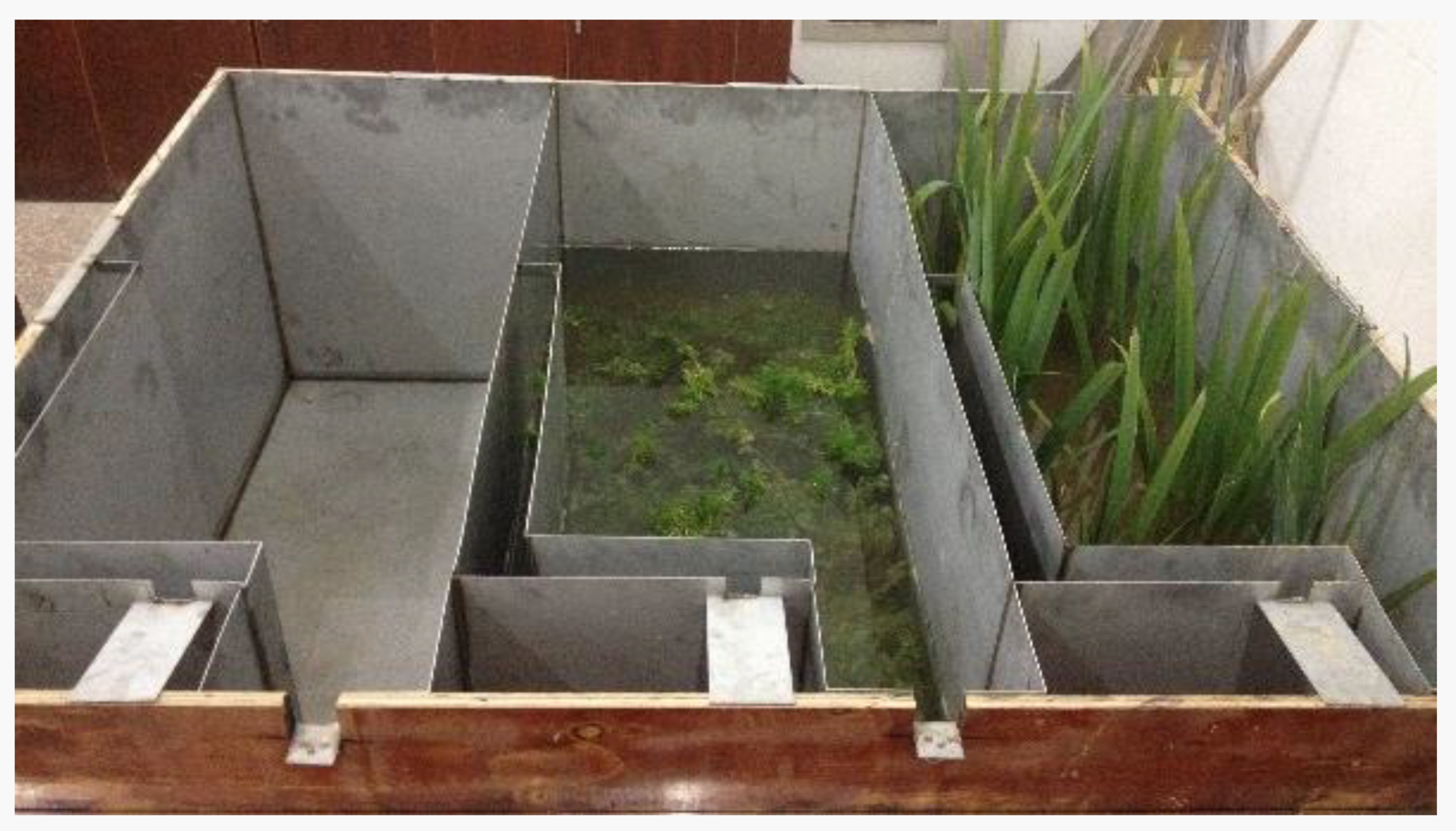
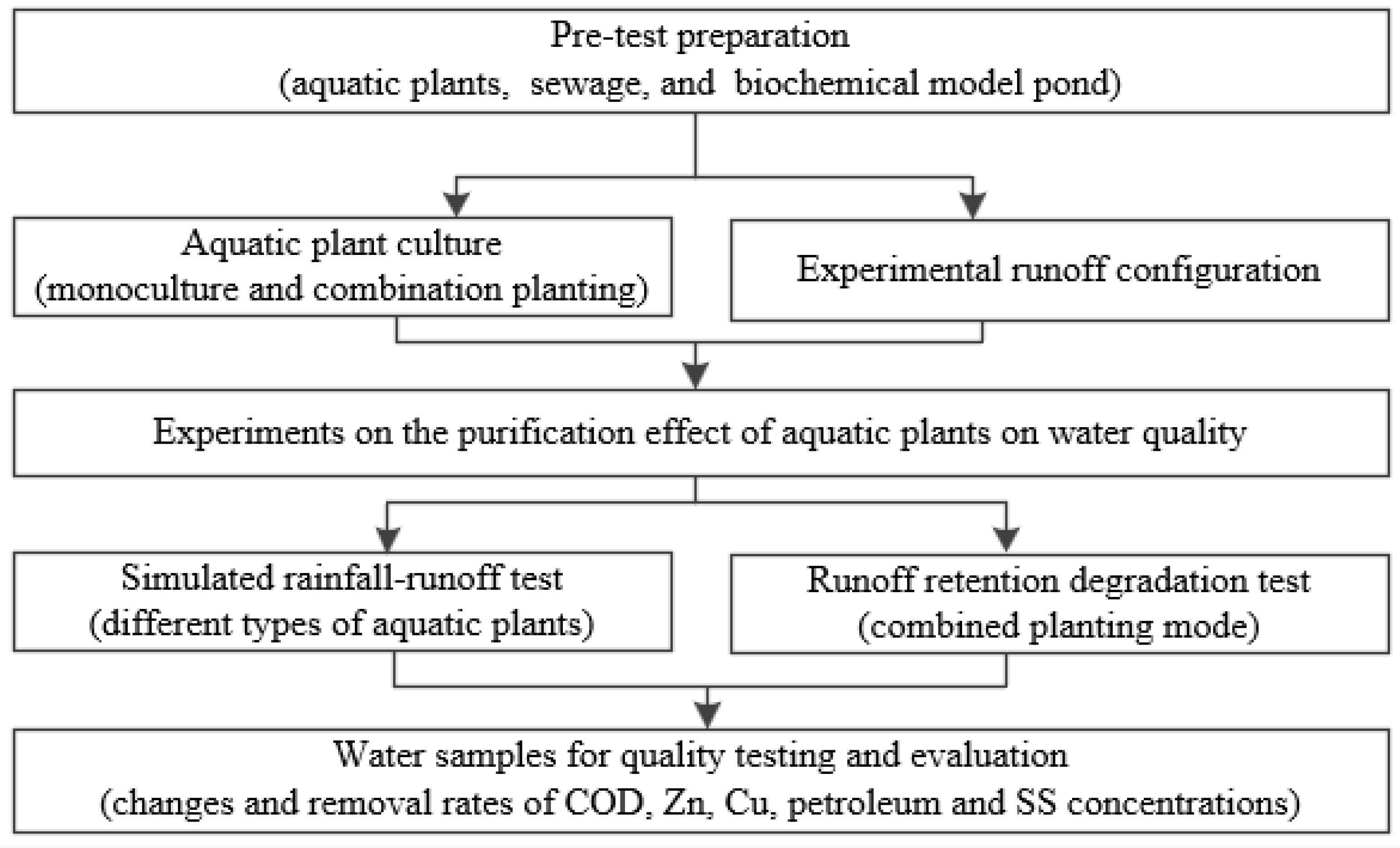
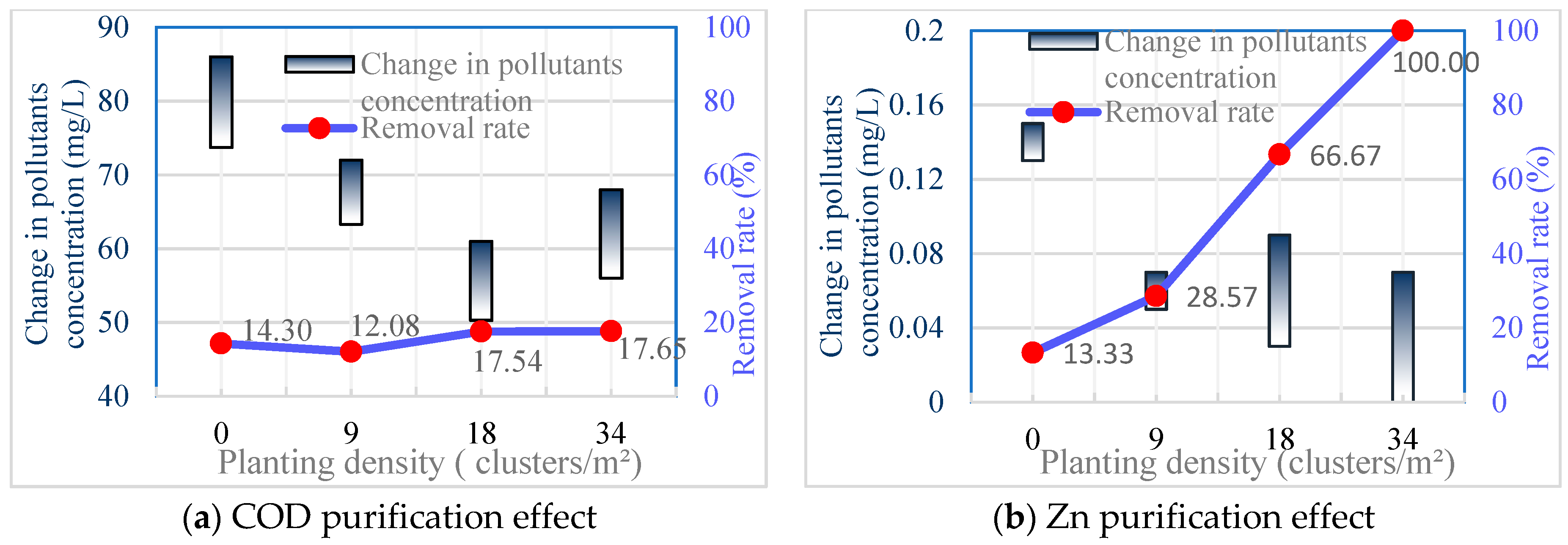


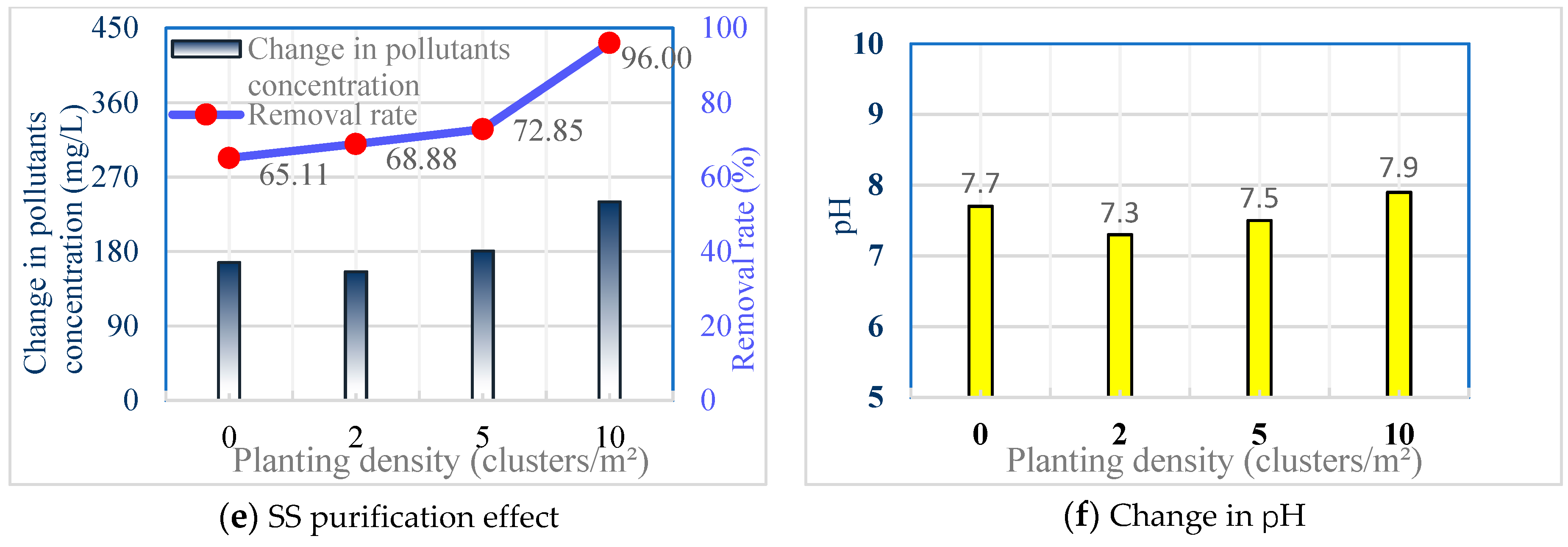

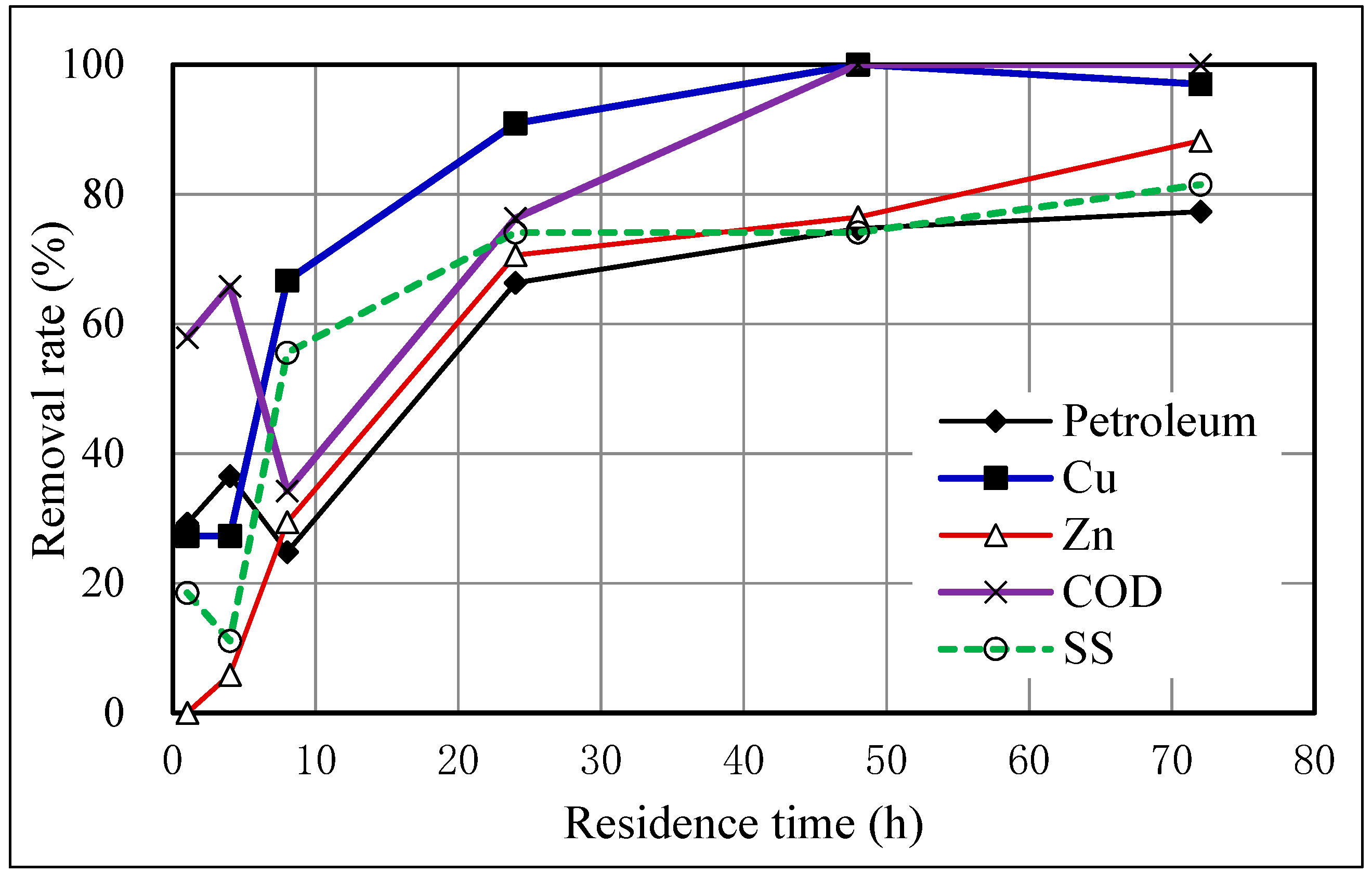
| Experiments | Aquatic Plant Cultivation Mode | Planting Density |
|---|---|---|
| Simulated rainfall-runoff test | Iris pseudacorus monoculture model | 34 bushes/m2, 18 bushes/m2, and 9 bushes/m2, 0 bushes/m2 (blank group) |
| Myriophyllum verticillatum monoculture model | 10 bushes/m2, 5 bushes/m2, and 2 bushes/m2, 0 bushes/m2 (blank group) | |
| Combination planting model (Iris pseudacorus + Myriophyllum verticillatum) | 34 clumps/m2 + 10clumps/m2 | |
| 18 clumps/m2 + 5 clumps/m2 | ||
| 9 clumps/m2 + 2 clumps/m2 | ||
| Runoff retention degradation test | Combination planting model (Iris pseudacorus + Myriophyllum verticillatum) | 18cluster/m2 + 5cluster/m2 |
| No. | Items | Test Specification | Test Equipment |
|---|---|---|---|
| 1 | COD | GB11914-89 | GDYS-201M Multi parameter water quality analyzer |
| 2 | Zn | GB7475-87 | GDYS-201M Multi parameter water quality analyzer |
| 3 | Cu | GB7475-87 | GDYS-201M Multi parameter water quality analyzer |
| 4 | Petroleum | SL93.2-94 | MAI-50G Oil content analyzer |
| 5 | SS | GB11901-89 | Oven, Electronic balance |
| 6 | pH value | GB5750-85 | GDYS-10SP Acidity tester |
| Residence Time | 1 h | 4 h | 8 h | 24 h | 48 h | 72 h |
|---|---|---|---|---|---|---|
| pH value | 7.9 | 8.0 | 8.0 | 8.1 | 7.7 | 7.4 |
© 2020 by the authors. Licensee MDPI, Basel, Switzerland. This article is an open access article distributed under the terms and conditions of the Creative Commons Attribution (CC BY) license (http://creativecommons.org/licenses/by/4.0/).
Share and Cite
Wang, Q.; Cao, H.; Yu, H.; Zhao, L.; Fan, J.; Wang, Y. Experimental Study on Purification Effect of Biochemical Pool Model for Treatment of Pavement Runoff by Aquatic Plants. Sustainability 2020, 12, 2428. https://doi.org/10.3390/su12062428
Wang Q, Cao H, Yu H, Zhao L, Fan J, Wang Y. Experimental Study on Purification Effect of Biochemical Pool Model for Treatment of Pavement Runoff by Aquatic Plants. Sustainability. 2020; 12(6):2428. https://doi.org/10.3390/su12062428
Chicago/Turabian StyleWang, Qinge, He Cao, Huanan Yu, Luwei Zhao, Jinchan Fan, and Yingqing Wang. 2020. "Experimental Study on Purification Effect of Biochemical Pool Model for Treatment of Pavement Runoff by Aquatic Plants" Sustainability 12, no. 6: 2428. https://doi.org/10.3390/su12062428





